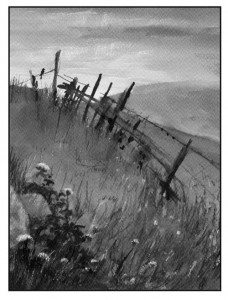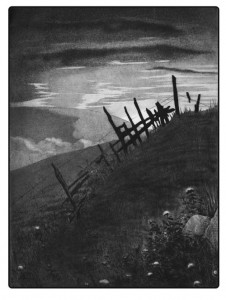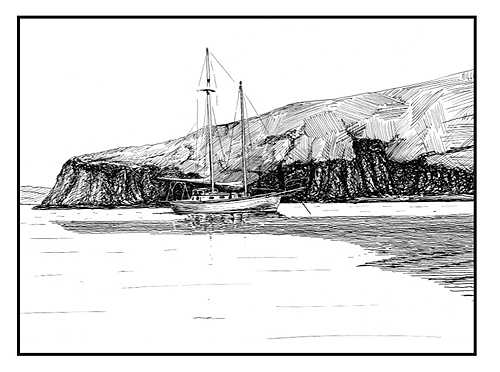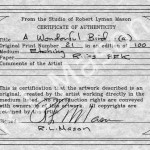SCHOONER MOON BOOKS
8. Tomales Debut
Taken from a photo dated about 1976 the ink wash drawing on the left was done in 1980 and then became the source for the etching plate on the right also done in 1980. Note the reversal of the image (see introduction). The old fence was seen while hiking on the Tomales Pennisula near White Gulch where my boat the GAMBELLA was anchored. See additional versions here.
(click on image for larger view)
9. Abandoned Fishing Boat
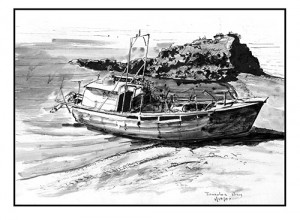
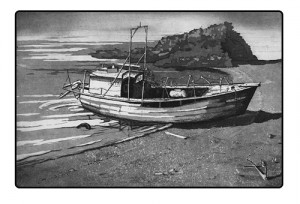 The pen and ink wash drawing on the left was done on location Jan. 19,1987. The scene was located on Tomales Bay near Marshall
The pen and ink wash drawing on the left was done on location Jan. 19,1987. The scene was located on Tomales Bay near Marshall
The etchig plate below was completed in 1989.
(click on image for larger view)
10. GAMBELLA Anchored at White Gulch
pen and ink 6 1/2 x 10
In this sketch, the GAMBELLA is anchored at White Gulch on Tomales Bay circa 1975. Tomales Bay is formed by the San Andreas fault. It is long, straight andnarrow. I made several trips there in the GAMBELLA and White Gulch was always my favorite anchorage.
Epilogue
Finishing this writing project twenty years after I first started has been an instructive experience. The journey came alive for me once again. Rereading what I had put down originally, and going back through the daily log that I kept at the time reinforced the common belief that your memory serves you best for the good parts and the bad parts fade. I am sometimes asked if I was lonely. The answer is yes. I knew, for me, loneliness, or “aloneness,” was conducive to creativity. I think this is especially true for writing. I have a good tolerance for interruption when working on an art project, but for writing, I need blocks of dedicated time. On the trip I was most productive when I was the loneliest. The solitude was deepened by the fact that the trip took place during a hiatus in my relationship with partner Evie Wilson, but I am happy to report this came to an end upon my return. Our partnership in life is still going strong as this project is completed. One other relationship that has endured is the one with my old friend and companion the van which is now closing in on 200,000 miles. And, of course there is our Sun, the home star. As for Georgia, she will live on in this book. It is apparent to me now that this journey was a time of introspection and self-examination on several levels, and I believe that I benefited from the process. It may not work for everyone, but the pilgrimage to Gobblers Knob to watch the Sun make a big circle in the sky helped me with a number of perspectives not all of which made it into this book. I shall always treasure them.
The essays that originally constituted Part II of this book may be found here.
Domestic Speculations
Robert T. Jones, Aerodynamicist
When I was a youth, in the years immediately proceeding and following adolescence, one of my best buddies was Ed Jones. Ed and his two sisters lived three doors from me in Palo Alto and I spent a lot of time at their house. Their father was Robert T. Jones, the famous Aerodynamicist. I didn’t realize how famous he was at the time. To me he was just their father and he worked for NASA, although the kids were fond of pointing out that their father had invented the swept back wing. Hanging out at the Jones’ house was a real education. Ed was a few years older than I and he had an old Model T. Ford truck that we were continually tearing apart and putting back together. In addition, we built countless model airplanes. In this latter endeavor we received the most expert instruction you could possibly imagine. There were also lessons in optics and electronics. Most of my instruction came to me second hand from Ed, but occasionally I got it straight from “R.T.” himself.
R.T. had a knack for making the strangest looking contraptions fly, and fly well. One in particular sticks in my memory. It was a flying wing, but more like half a flying wing. It was almost all wing and it was straight, but it flew on a bias. In flight, one end would lead by quite a bit and the other end would trail. Looking at it made you scratch your head and think, “How could such a configuration possibly fly?” but it did. R.T. called it an “oblique flying wing.” Many years later, after he retired from NASA and was associated with Stanford University, he spent time developing this concept further. What eventually emerged was a fairly complete design for a Mach 1.6 aircraft that could seat 440 passengers inside a wing with a span of 400 feet. Of course, you don’t see anything like that flying today. It was just too strange for the public to accept. As R.T. himself once wrote “artifacts created by humans show a nearly irresistible tendency for bilateral symmetry” (10). If one of these wings were to appear in the sky without warning you would immediately be struck by the almost “unearthly” quality of its appearance.
There probably are aircraft of various types and configurations under development at secret facilities, and no doubt they contributed from time to time to the total inventory of UFO sightings. The recent unveiling of the stealth bomber and fighter is an example of this kind of secret development.
Area 51
Among UFO enthusiasts are those that frequent the small town of Rachel, Nevada, located near area 51 and the “secret” base at Groom Lake. There you can sign up for a guided evening trek up into the Nellis Range over looking the base. I have never done this, but I understand that on Wednesday nights at a certain location, it can be a very interesting experience, or at least it used to be. The most common description of what was seen involves a ball of brilliant light that changed altitude in a stepped fashion, exhibited terrific accelerations, and made sharp turns at very high velocities. this has all the ear marks of a beam of some kind directed from either above or below –– probably below. But how could such a beam be made to exhibit a bright ball of light without hitting a target or passing through a layer of gas and thus causing fluorescence? I don’t know, but I am addicted to speculating about this kind of thing.
If there was a device similar to the linear accelerators described in the previous chapter that produced a particle beam of some kind, maybe there is a way to run something up and down that beam. Suppose this device produced a beam of protons or positive ions and accelerated them to high velocity. And suppose there was a way of superimposing a wave function on this beam. I envision this as looking like stop-and-go traffic on a freeway when viewed from above. And further, suppose there is a way of controlling the phase velocity of this wave. This gets me back to R.T. Jones again.
In the early days of television, when I was somewhere in the range of ten to twelve years old, I happened to walk into the Jones’s living room one day and noticed what I thought was a TV. not everybody had one in those days, and I commented on its presence. R.T. was nearby and he informed me that what I was looking at was actually an oscilloscope.
“What’s an oscilloscope?” I asked, stumbling over the pronunciation.
“Do you know what oscillation is?”
“Uh huh”, I replied with a nod, not wishing to appear ignorant.
He looked at me for just a moment and an almost imperceptible smile crept over his face.
“Well, oscillation is when something moves back and forth between two limits like the pendulum on a clock.”
I remember being embarrassed that he had seen through me so easily. He then turned on the scope and gave me a lesson in its use. the image that sticks in my head to this day was the standing sine wave that he produced on the screen. He made it proceed to the right slowly at first then gradually faster until the wave was just a blur. He then slowed it down again until it was motionless again, all the while explaining about frequency and phase velocity. Anybody who has worked with an oscilloscope has seen what I have just described. Much later, when I worked for the Radiation Division of Varian Associates, I was impressed with the fact that the phase velocity of a radio frequency signal can be used to move particles down the length of an accelerator’s tube, and accelerate them in the process.
So, what if we pass a positive beam through a small synchrotron-like device that has electrons whirling around in it, and we pass the beam through the synchrotron along its axis of rotation. Would there be a way of hanging a ring of electrons on the positively charged beam? And could this ring be moved up and down the beam or be held steady at some location by adjusting the phase velocity? and since the ring of electrons would give off what is called synchrotron radiation from being constantly held to a circular path, would this electromagnetic radiation be in the visible portion of the spectrum? There are a lot of questions here and not many answers.
After thinking about this a little more, I realized the synchrotron is not necessary. All you need is a small linear accelerator arranged perpendicular to the larger positive beam. This linac would put out a stream of electrons at just the right velocity and distance from the center of the positive beam so that they go into a stable orbit around the stream of positive particles. The phase velocity of the positive beam could be adjusted so the positive peak of a standing wave (zero phase velocity) was at the intersection of the two beams while the orbit was being established. Once established, the phase velocity of the positive or carrier beam could be increased, sending the ring on its way. (see A Hard Look at UFOs)
After writing the above I decided to see if anybody else had come up with the idea of linking particle beams and UFOs and this led me to the web site authored by Tom Mahood entitled Bluefire (11). From his site, I gathered that Tom was at one time an area 51 groupie, but has since reformed and is now a physicist. This combination of attributes provides him with a unique perspective on the question of UFOs sighted over area 51. Tom speculates that a particle beam aimed up into the atmosphere would, depending upon the initial energy and velocity, produce a ball of plasma at some altitude, and he provides some impressive mathematics to back this up. Coming out of the accelerator at high velocity the beam would initially shoulder aside molecules of air, but would gradually attenuate to the point where it would eventually collide with these molecules and dump its remaining energy creating a ball of plasma. A good deal of the resulting electromagnetic radiation would be in the visual portion of the spectrum but it would also show up as a false bogie on radar screens, and he suggests that is where the military interest lies. Mahood notes a paragraph from David Darlington’s book, Area 51 — The Dreamland Chronicles[06]. Darlington, quotes Mark Farmer and because it is such a descriptive passage, I will quote it also:
“I’ve seen two of them out here,” Farmer divulged.
“One was a light that kept bouncing around and then just went away. The other was colored, floating, glowing orb that popped up behind the jumbled mountains south of Groom Lake. It went straight up, then started jerking around and wobbling up and down — at times making right-angled, or greater than right-angled, turns then sitting still in a rock-hard hover. It became distorted when it moved part of it lagged behind the main object, then the trailing edge would catch up. I had a Celestron twelve-hundred- millimeter telescope, and I watched it for an hour and forty-five minutes. It wasn’t quite round; it was sort of squashed, and shimmering the whole time as if it were surrounded by some kind of field. It was crimson on top, blue-green on the bottom, and gold in the middle. I have no idea what it was” (12).
After reading his on-line essay “Particle Beams and Saucer Dreams,” (13) I had the feeling that Mahood is probably closer to established science than I am, but who knows what is yet to be established? I’ll touch on this kind of thing again in the next chapter, but from a different point of view. (Click here to read Mahood’s essay)
Historical Coincidence?
The first particle accelerator, a cyclotron, was built in the early 1930s, but they really didn’t proliferate until the invention of the synchrotron and the linear accelerator in the mid 1940s. I think it is interesting to note that the modern era of UFOs is generally considered to begin in 1947. As Tom Mahood speculates, the military interest in accelerators probably has to do with their ability to create a false radar target. Just how much development and distribution the resulting device has received is unknown, but I get suspicious whenever I read about UFOs being sighted in conjunction with large military maneuvers or naval exercises.
(10)
Robert Thomas Jones, May 28, 1910 — August 11, 1999 by Walter G. Vincenti /
Biographical Memoirs, National Academy of Sciences
(11)
http://www.serve.com/mahood/bluefire.htm
(12)
[06] p. 237
(13)
http://www.serve.com/mahood/probeams.htm
Prologue
The stretch of coast between Half Moon Bay and Point Año Nuevo, California is one of my favorite settings. In total, it is perhaps only twenty miles or so and includes the villages of San Gregorio and Pescadero.
While driving south from Half Moon Bay, on the left is rolling agricultural land and on the right a view of surf, cliffs, and rocks. Highway One becomes an ecotone between pastoral and marine. Looking out to the horizon you can often see ships, fishing boats, and occasionally the spout of a gray whale as it migrates north or south along the coast. About half way between Pescadero and Año Nuevo is Pigeon Point which is graced by a lighthouse straight from a picture book.
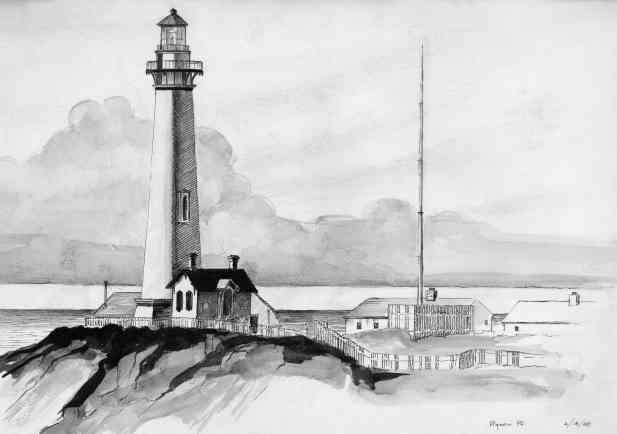
Lighthouse at Pigeon Point
Pigeon Point was my destination early in the spring of 1986, as it had been many times before. It is a truly magical spot and it’s my favorite place to watch the Sun set. As I drove south in the late afternoon light, I was once again struck by the beauty of the area. All the hills were green with spring, and fleecy clouds left over from a late season storm were blowing in from the horizon. Row upon row of artichokes flashed by to my left while cattle and sheep could be seen grazing on the hills in the distance.
Since Pigeon Point is only an hour’s drive from Palo Alto, I often went there when I needed a break in my daily routine. It has the advantage of being close while seeming far away. As the light fades, the sound of surf predominates along with the flash of the beacon at the lighthouse. One could, at that time, park right on the edge of the cliff and look down about 40 feet to the surf dashing against the rocks below. Low tide reveals a plethora of tide pools. At night the lights of the fishing boats are stippled along the horizon and, when the moon is not out, the milky way is plainly visible. You sleep to the primal rhythm of the surf. Eternal . . . eternal . . . eternal; the sound of the surf is one of only a few sounds I can think of that connect us so directly with the eternal.
Upon arriving that evening in 1986, I settled down with a glass of wine just north of the lighthouse. As I watched the Sun slip out of sight, I wondered if I would find a spot to match this during my trip north. Maybe, and what else would I find . . .
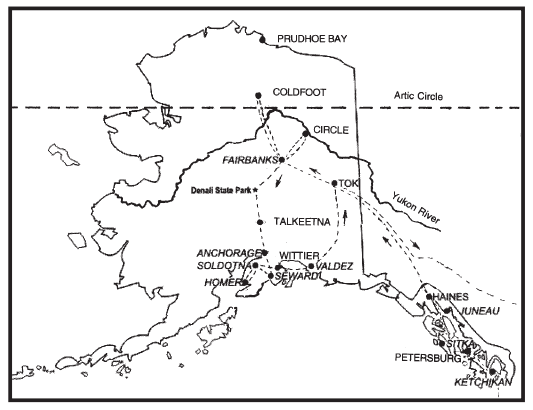
Alaska Travel Route

Introduction
Starting in May of 1986, I took a year off from my regular position as Artist-in-Residence for the Pacific Art League in Palo Alto, California. Having hired and trained an assistant to run my framing business, I intended to take a sabbatical and see some of the United States. Two fine books, Travels with Charlie by John Steinbeck and Blue Highways by William Least Heat Moon, helped inspire my decision to make such a trip. In addition, I wanted to sort out some philosophical thoughts I had been mulling over in my mind for a number of years. Such a trip would provide the opportunity. To begin my wanderings, I decided the first leg should go as far north as possible and that led me to Alaska. This book chronicles that journey.
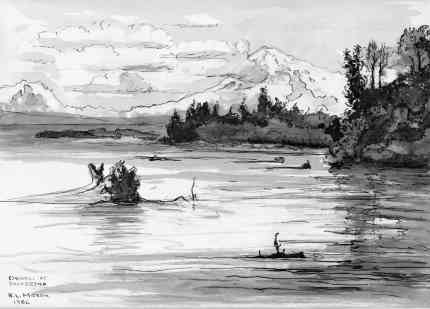
Denali at Talkeetna by R L Mason
Somewhere I had heard of the Japanese custom of keeping a “legacy,” a large book in which the head of a family wrote down his thoughts on life and other matters. The book was passed down through the generations with each successor adding his own thoughts. This practice appealed to me since I was curious about my ancestors and yet knew so little about them. Also, I was fascinated with the enduring nature of books. I had read the Autobiography of Benvenuto Cellini and the Travels of Marco Polo. I marveled at how a book could provide a direct communications link between people of different times. Both authors were able to speak directly to my mind from their minds over periods of five and seven hundred years. It amused me to envision my descendants smiling at my quaint expressions five hundred years from now.
Age fifty (almost) seemed like an appropriate time of life to start such a project. At that age you are still young enough to have all your wits about you, yet old enough to have had a fair amount of experience with the world. You should have lost a good deal of naiveté and gained objectivity. You should have a pretty good handle on which of those “lessons” you were taught as a youth were sound and which didn’t hold water. You may even have a fresh insight, or rarer still, an original thought.
You have to have something of an ego, of course, to even attempt such a project, but low self-esteem has never been a problem of mine. On the other hand, I have no illusions about changing the course of history with this book. If it is never
read by anyone other than my daughter and granddaughter, that will be enough. I did feel a nagging sense of obligation and I think this springs from a vague notion that a life should somehow “bear fruit;” that something in addition to progeny should be left behind at the end. Being an artist has helped fulfill this need, but a work of art lacks the specificity of the written word, and I wanted to be more specific.
I don’t pretend to be an expert on any of the subjects and disciplines that are touched on in this book. The only subject I claim expertise for is my own opinion, and the reader will soon discover that I have opinions. Prefacing every personal conclusion with “it seems to me” or “as I understand it” does get rather tiresome, so I ask that the reader plug these words in mentally whenever I begin to sound instructive. They are, after all, only opinions. Finally, I have decided even though this book is a personal project, I might as well do it in a finished manner. At least I should try for broad appeal, although I would consider broad readership a bonus. An account of my trip provides the structure for introducing a number of diverse thoughts and is also a story in its own right. Much of this book was drafted at that time. Upon returning, however, and reengaging in the process of making a living, the project languished. I was determined to complete the project upon retirement, and did so with the help of a daily log which I kept on the trip, as well as photographs, tape recordings, and sketches done on location.
The essays that originally constituted Part II of the book may be found here.
Introduction
This book contains reproductions of sketches and etchings done during the period from 1975 to the present. The images are California coastal scenes ranging from Trinidad above Eureka in the north, to Limekiln Beach near Lucia on the lower Big Sur coast. Also included are a number that were accomplished in the San Francisco Bay Area. Most were done from the perspective of the shore, but some were completed from the waterside using the GAMBELLA, a boat that I owned in the early years. In a number of images the GAMBELLA is the subject matter.
The sketches are executed in pen and ink and some contain tonal areas of ink wash. There is one exception, a pencil drawing of the GAMBELLA. The balance of the images are etchings.
What is an etching?
An etching is one of several original print mediums. Other original print mediums include engravings, woodcuts, linocuts, lithographs (from a stone), silk-screens, and monotypes.
An original print is presented in the same medium in which it is accomplished as opposed to a reproduction which is usually a conversion from some other medium. The conversion is made to a print medium such as offset lithography and involves a camera of some kind. Original prints are usually produced in limited editions which are numbered and signed by the artist. In addition, a Certificate of Authenticity is often provided.
How are etchings made?
An etching is printed off of a metal plate, usually copper or zinc, which has the image incised into it. The incising is accomplished by selectively exposing the plate to an acid which “bites” the plate to form the image. The plate is initially covered with an acid resist called a “ground” and then worked with a sharp point to expose the metal beneath the ground. The plate is then submerged in an acid bath which etches the plate where the metal has been exposed. The printed lines thus produced have a look very similar to those produced by a pen. There is a similar process called “aquatint” that produces tonal areas which, when printed, are close to the look of an ink wash. Consequently, sketches accomplished in pen and ink wash translate quite nicely to etchings with aquatint.
Making the plate is usually in iterative process. Some work is done on the plate and then it is “proofed” to check on its current state. Then more work is done and the plate is proofed again. This continues until the artist is satisfied that the image printed is what was intended. This procedure is necessary because the artist works in the negative (light lines on a dark surface) and in reverse (mirror image). When the plate is complete the edition is printed. Printing is accomplished by smearing the plate with an oil based ink. The surface of the plate is then wiped clean leaving the ink in all the incised areas. The inked plate is placed on the “bed” of an etching press, covered with a piece of damp, high quality paper and run through the press under high pressure. The paper is forced into the incised areas of the plate, contacting the ink and printing the image. The whole process, including the printing, is handwork and labor intensive. An etching can usually be identified by the impression of the edge of the plate embossed around the perimeter of the image.
The problem of reversal.
As mentioned in the preceding paragraph the image printed is a mirror image of what is incised into the plate. In the case of some generic images, this is unimportant. But when the image is a well known scene or contains printed words, it can be a problem. There are several ways around this problem:
- When working directly on the plate from nature, one can use an interceding mirror. I have, on occasion, positioned my van so that the subject matter is reflected in the outside rear view mirror.
- When a sketch is accomplished prior to the etching, its basic features can be transferred to the ground on the plate face down to act as a guide for “needling” the plate.
- A counterproof can be made from a freshly printed image. This is done by placing another sheet of paper over the image while the ink is still wet and running it back through the press under pressure.
A word of warning.
There are some galleries (and artists) who will attempt to pass off reproductions as original prints. They will number and sign the image and provide a Certificate of Authenticity. Sometimes they will even go to the extent of embossing a plate mark around the image. This is ethically questionable but legal as long as they use the word “reproduction.” If they call it an original print, they have definitely overstepped. Any time you see edition numbers that run into the thousands you are probably looking at a reproduction. In this book there are reproductions of 42 sketches and 25 etchings. The distinction and a brief description appears on the facing page. In addition, the sketches have borders with sharp corners and the etchings have borders with slightly rounded corners. In some cases both the sketch and the etching that was made from it are shown. Enjoy!
R. L. Mason
Introduction
Let me admit, right from the start, that this field of study is extraordinarily polluted. the paucity of hard facts has allowed imaginations to run wild, hoaxes to be perpetrated, fraud, and outright lies. in addition, a large number of reports (perhaps the majority) are simply misidentifications or misinterpretations of familiar objects or phenomena. But is there a signal hidden in all this noise?
UFO’s exist, of course, that is, Unidentified Flying Objects exist. If a flying object is observed which cannot be identified then it is a UFO by definition. The key question is whether there is an extraterrestrial intelligence behind any of them, and that is where the confusion starts. Go into any book store and ask where the shelf containing books on this subject is, and you will receive directions to the section on the occult, mysticism, the paranormal, and metaphysics. There, nestled in with Bigfoot and poltergeists you will find the books on the subject at hand. I don’t see how there could be any clearer testimony to the feeling of the general public (not to mention the scientific community) when the subject of UFO’s is broached. even those who bill themselves as UFO investigators or “ufologists” are a pretty erratic lot, tending toward sensationalism, continually quoting or disagreeing with each other. You have to move mountains of detritus to find a few flecks of gold.
Some authors on this subject have been proven to be fraudulent. long before space probes established that the planet Venus has a surface temperature that can melt lead, and is an arid inferno of crushing atmospheric pressure and acidic clouds, George Adamski claimed, in the book Flying Saucers Have Landed [07], to have had a conversation with a christ-like alien being who informed him he was visiting from Venus.1 All of the above has caused serious, scientific investigators to avoid the subject like the plague. I am not a scientist; I’m an engineer with some exposure to particle accelerators. Being an engineer probably gives me a slightly different slant on things. engineers are usually more concerned with how things can be made to work (technology) as opposed to the basic nature of things (science). the reader may detect that inclination in this book.
Until I read The UFO Experience: A Scientific Inquiry[13] by J. Allen Hynek I was quite skeptical concerning the whole subject. Since reading the book I have moved from negative to neutral, or agnostic and very curious. Dr. Hynek convinced me that some physical phenomena is being observed that deserves serious investigation. But what is it? in this book speculations are offered in three general categories: natural causes, domestic technology, and alien technology. But perhaps more importantly, a new way of looking at the phenomena is proposed that finds itself at home in any of these three possibilities. More space has been given to possible alien technologies because of the far-reaching implications for the human race.
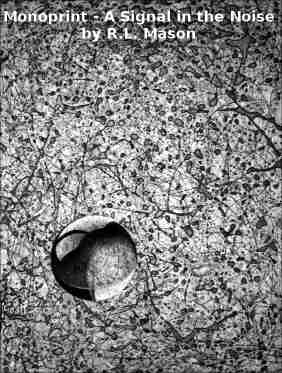
Monoprint - A Signal in the Noise by R.L. Mason
Writing this book has been a personal adventure of the mind which is why it is written in the first person. The tale unfolds roughly in the sequence of the adventure with recollections and research inserted where they seemed to fit best. The initial motivation grew out of ten years worth of conversation with Gordon Chism whose own adventure is included in chapter 2. Gordon is a firm believer in an alien presence, and if I had been in his shoes, I might be too. However, I am a natural born skeptic. I am sure Gordon’s account is accurate, but I had doubts about his interpretation. So I had to ask myself “okay, what did he see?” Chapter 3 is a summary of my first attempt at answering that question, and although it was an interesting exercise, it ended up inconclusive. in succeeding chapters I wander off in other directions, explore other avenues, and learn much in the process. eventually, in chapter 13, I come full circle and return to my starting point armed with new knowledge and what I believe is a unique perspective. In short, what we have here is a puzzle. I have always enjoyed trying to solve puzzles, and in this case the reader is invited along for the adventure.
Citations
1 [07] p. 198
2 [13] p. vii
Categories
- THE GALLERY
- Uncle Rob's Art
- 3D Works (stills) I
- 3D Works (stills) II
- 3D Works (stills) III
- 3D Works (video)
- Design & Abstract I
- Design & Abstract II
- Design & Abstract III
- Figurative Works I
- Figurative Works II
- Landscapes I
- Landscapes II
- Largest Art Project
- Nautical and Marine Images (video)
- Nautical and Marine Images I
- Nautical and Marine Images II
- Nautical and Marine Images III
- Nautical and Marine Images IV
- Portraits
- Still Life Images
- Stump Hollow Photo Essay I
- Stump Hollow Photo Essay II
- Uncle Rob's Mendocino Shop
- The Five Sense Series
- Irene's Creations
- Works by Don Mason
- Works by Don Mason II
- Works by Joseph de Borde
- Painting by Albert Robbins
- Art by Leslie Masters Villani
- Paintings by Nellie Harriet Parker
- The Art of Bee Yearian
- Works by Evie Wilson
- Uncle Rob's Art
- SCHOONER MOON BOOKS
- SEA STORIES
- ONE DOZEN AND TWO ESSAYS
- Cousinhood
- Art by Definition
- Cake Mixed Economy
- Marriage Anyone?
- Sex and/or Violence
- Searching for Truth
- The Philosophical Roots of Science
- Stepping Stones and Stumbling Blocks
- On Being Good
- Teaching By Example
- The Basic Law of Civilization
- Where Goeth Evil?
- A Modern Empircal "Religion"
- Knowledge as Wealth
- PAPERS AND ARTICLES
- FAMILY STORIES
- BOOK REVIEWS
Archive
- December 2021
- October 2020
- June 2020
- September 2019
- July 2017
- March 2017
- December 2016
- November 2016
- October 2016
- August 2016
- July 2016
- June 2016
- May 2016
- March 2016
- February 2016
- February 2015
- January 2015
- February 2014
- December 2013
- November 2013
- August 2013
- June 2013
- August 2012
- July 2012
- April 2012
- March 2012
- February 2012
- November 2011
- September 2011
- June 2011
- May 2011
- April 2011
- March 2011
- February 2011
- January 2011
- December 2010
- November 2010
- October 2010
- September 2010
- August 2010
- July 2010
- June 2010
- May 2010
- April 2010
- March 2010
- February 2010
- January 2010
- December 2009
- November 2009
- October 2009
- September 2009
- August 2009
- July 2009
- June 2009
- May 2009
- April 2009
- March 2009
- February 2009
- January 2009
- December 2008
- November 2008
- October 2008
- September 2008
